
Lindsborg is a city in McPherson County, Kansas, United States. As of the 2020 census, the population of the city was 3,776. Lindsborg is known for its large Swedish, other Nordic and Scandinavian Americans (Nordic-Scandinavian), and German heritages, It is home of the biennial Svensk Hyllningsfest.
Frederic Joseph DeLongchamps was an American architect. He was one of Nevada's most prolific architects, yet is notable for entering the architectural profession with no extensive formal training. He has also been known as Frederick J. DeLongchamps, and was described by the latter name in an extensive review of the historic importance of his works which led to many of them being listed on the U.S. National Register of Historic Places in the 1980s.

Bonsecours Market, at 350 rue Saint-Paul in Old Montreal, is a two-story domed public market. For more than 100 years, it was the main public market in the Montreal area. It also briefly accommodated the Parliament of United Canada for one session in 1849.

The National Farmers' Bank of Owatonna, Minnesota, United States, is a historic bank building designed by Louis Sullivan, with decorative elements by George Elmslie. It was built in 1908, and was the first of Sullivan's "jewel box" bank designs. The building is clad in red brick with green terra cotta bands, and features two large arches on its street-facing facades. Single-story wings, originally housing bank offices, extend along each side. Internal elements include two stained-glass windows designed by Louis J. Millet, a mural by Oskar Gross, and four immense cast iron electroliers designed by Elmslie and cast by Winslow Brothers Company.
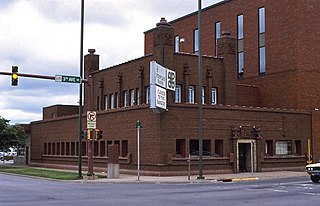
The Peoples Savings Bank in Cedar Rapids, Iowa, was designed by Louis Sullivan. It was the second of a number of small "jewel box" banks in midwest towns designed by Sullivan during 1907 to 1919. It was built in 1911, and it was individually listed on the National Register of Historic Places in 1978. In 2014 it was included as a contributing property in the West Side Third Avenue SW Commercial Historic District.
Philip Hooker was an American architect from Albany, New York known for Hyde Hall, the facade of the Hamilton College Chapel, The Albany Academy, Albany City Hall, and the original New York State Capitol building.

The Farmer's and Manufacturer's Bank building is located at the corner of Market and Cannon Streets in downtown Poughkeepsie, New York, United States, near the Bardavon and across from the Dutchess County Court House and Old Poughkeepsie YMCA. It is one of only two non-residential Greek Revival buildings remaining in the city.
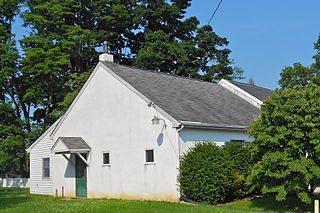
Ercildoun, population about 100, is an unincorporated community in East Fallowfield Township, Chester County, Pennsylvania, United States. The hamlet was founded by Quakers and was an early center of the abolitionist movement. In 1985 the entire hamlet, including 31 properties, was listed as a historic district on the National Register of Historic Places. Of these properties two were vacant land, 14 were significant buildings, ten were contributing buildings, and five buildings, built in the 1950s, were non-contributing. The Lukens Pierce House, an octagon house listed separately on the U.S. National Register of Historic Places, is located about half a mile northwest of the hamlet. Ercildoun is one of about ten hamlets in the township, which has no cities or towns, but has 31 sites listed on the National Register. It is one of the larger hamlets, located near the center of the township, and historically among the best known. The city of Coatesville is about 3 miles north.

Farmers National Bank is a bank building in the village of Plain City in Madison County, Ohio, United States. The bank is located at the intersection of State Route 161 and Chillicothe Street. Built in 1902, it was listed on the National Register of Historic Places in 1995.
Farmers State Bank or Farmers State Bank Building may refer to:

Ponce City Market is a mixed-use development located in a former Sears catalogue facility in Atlanta, with national and local retail anchors, restaurants, a food hall, boutiques and offices, and residential units. It is located adjacent to the intersection of the BeltLine with Ponce de Leon Avenue in the Old Fourth Ward near Virginia Highland, Poncey-Highland and Midtown neighborhoods. The 2.1-million-square-foot (200,000 m2) building, one of the largest by volume in the Southeast United States, was used by Sears, Roebuck and Co. from 1926–1987 and later by the City of Atlanta as "City Hall East". The building's lot covers 16 acres (65,000 m2). Ponce City Market officially opened on August 25, 2014. It was listed on the National Register of Historic Places in 2016.

The Wall Street Historic District in New York City includes part of Wall Street and parts of nearby streets in the Financial District in lower Manhattan. It includes 65 contributing buildings and one contributing structure over a 63-acre (25 ha) listed area.

Davenport Bank and Trust Company was for much of the 20th century the leading bank of the Quad Cities metropolitan area and the surrounding region of eastern Iowa and western Illinois. It was at one time Iowa's largest commercial bank, and the headquarters building has dominated the city's skyline since it was constructed in 1927 at the corner of Third and Main Streets in downtown Davenport, Iowa. It was acquired by Norwest Bank of Minneapolis in 1993 and now operates as part of Wells Fargo following a 1998 merger of the two financial institutions. The historic building was listed on the National Register of Historic Places in 1983 under the name of its predecessor financial institution American Commercial and Savings Bank. In 2016 the National Register approved a boundary increase with the Davenport Bank and Trust name. It was included as a contributing property in the Davenport Downtown Commercial Historic District in 2020. It remains the tallest building in the Quad Cities, and is today known as Davenport Bank Apartments as it has been redeveloped into a mixed-use facility housing commercial, office and residential space.

The Jamaica Savings Bank was a bank incorporated in 1866 in the Jamaica section of the borough of Queens in New York City. It had four branches across Queens before it was acquired by North Fork Bank in 1999, which itself was acquired by Capital One Bank in 2008.
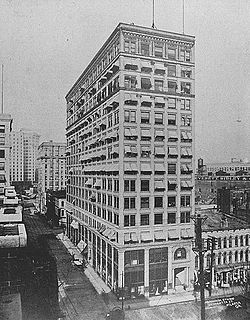
The J. Mack Robinson College of Business Administration Building is a 14-story highrise at the corner of Broad and Marietta streets in the Fairlie-Poplar district of downtown Atlanta, which houses the business school of Georgia State University. When completed in 1901 as the Empire Building, it was the first steel-frame structure and the tallest in the city, until surpassed by the Candler Building in 1906.
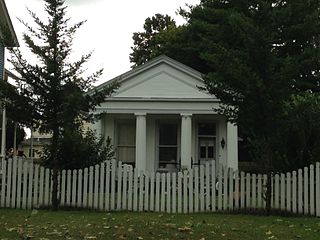
The Paine Bank is a historic bank building located at 1008 Oak Street in Niles, Michigan. It was listed on the National Register of Historic Places in 1973.

The Farmers and Mechanics Bank is a historic building in the Georgetown neighborhood of Washington, D.C. Constructed between 1921 and 1922, the bank was first the headquarters of the Farmers and Mechanics National Bank. Soon thereafter, it became known as the Farmers and Mechanics Branch of Riggs National Bank. In 2005, the building became a branch of PNC bank.
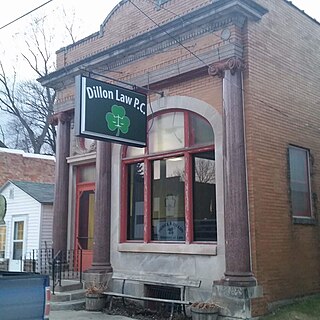
Farmers' State Bank is a historic building located in Volga, Iowa, United States. Its significance is derived from its Beaux-Arts architecture and the bank's role in the town's early 20th-century agriculture-based economy and railroad development along a branch of the Chicago, Milwaukee & St. Paul Railroad. Completed in 1912, the Beaux Arts elements on the buildings main façade includes a large elliptical-arch window, Ionic granite columns, classical entablature, and circle window above the door framed by garlands. Farmers' State Bank was Volga's second financial institution. It survived the downturn in the farm economy in the 1920s before it merged with the other bank in town in 1931 to form Iowa State Savings Bank. That bank used this building until the following year when it failed. The city of Volga acquired the building in 1935 and used it for its public library and city hall. It was used for a bank again from 1947 to 2015 when it housed Volga State Bank and the Volga branch of Central State Bank of Elkader. The building then housed a law office. It was listed on the National Register of Historic Places in 2018.

















